Copula-Based Joint Drought Index Using Precipitation, NDVI, and Runoff and Its Application in the Yangtze River Basin, China
Abstract
:1. Introduction
2. Materials and Methods
2.1. Study Area
2.2. Data
2.3. Assumptions and Methodology
2.3.1. Single-Element Drought Indices Calculation
2.3.2. Definition and Calculation of SCDI
2.3.3. Evaluation Criterion of Index
2.3.4. Characteristics of Drought
- If the SCDI equals 1 (i.e., SCDI = 1), it is directly considered a drought process.
- When D equals 1 (i.e., D = 1), if the monthly SCDI is less than −1.5, it is classified as a drought process; otherwise, it is not established as a drought event.
- If the time interval between two adjacent drought processes is only one month and the value of SCDI is below −0.5 for that month, they are considered a single continuous drought event. The total combined duration (D) is the sum of the duration of the two events plus 1, and the combined intensity (S) is the sum of their intensities.
3. Results
3.1. Joint Distribution of Three Elements
3.1.1. Selection of Marginal Distributions
3.1.2. Selection of Pair-Copula Distributions
3.1.3. Reduction of Lag Effect
3.2. Performance of the SCDI
3.2.1. Consistency, Sensitivity, and Accuracy
3.2.2. FNR and FPR
3.2.3. Contrast between the SCDI and Single-Element Indices
3.3. Universality Analysis of the SCDI
3.4. Analysis of Drought Characteristic Evolution
3.4.1. Temporal Evolution Feature
3.4.2. Spatial Evolution Feature
4. Discussion
4.1. Selection of Multivariate Copula Parameters
4.2. Lag Effect of the NDVI
4.3. Synthesis of Different Types of Droughts
4.4. Drought Assessment in the Yangtze River Basin
5. Conclusions
- (1)
- The SCDI exhibits a superior drought monitoring performance. It accurately identified the onset and cessation of drought, characterized all drought events in the Wuhan-Hukou Basin, and maintained low false negative and false positive rates. By combining precipitation, NDVI, and runoff, the SCDI simultaneously characterizes meteorological, hydrological, and agricultural droughts.
- (2)
- The NDVI exhibits a lag effect on the construction of the SCDI. The sensitivity of the SCDI to the VCI increased from 47.8% to 53% when shifting the NDVI time series data forward by one month in sequence during the SCDI’s calculation. This indicates that the SCDI demonstrates a more effective drought monitoring capability after accounting for the lag effect of the NDVI.
- (3)
- The SCDI applies to all third-level sub-basins of the Yangtze River Basin. While there is some spatial heterogeneity in correlation, consistency, and sensitivity, the quantitative indicators’ results fell within a reasonable range, and the false negative and false positive rates remained between 0 and 20%. Therefore, the SCDI exhibits good applicability in the Yangtze River Basin.
- (4)
- From the perspective of time, the droughts of all grades in the Yangtze River Basin showed a fluctuating trend from 2001 to 2018, with December 2008 being the most severe drought month. From the perspective of space, the characteristics of drought from 2001 to 2018 exhibited evident spatial heterogeneity. The western region experienced low drought frequency, high intensity, and long duration, while the eastern part showed the opposite.
Author Contributions
Funding
Data Availability Statement
Conflicts of Interest
References
- Zhou, Z.; Shi, H.; Fu, Q.; Li, T.; Gan, T.; Liu, S.; Liu, K. Is the cold region in Northeast China still getting warmer under climate change impact? Atmos. Res. 2020, 237, 104864. [Google Scholar] [CrossRef]
- Jiang, W.; Niu, Z.; Wang, L.; Yao, R.; Gui, X.; Xiang, F.; Ji, Y. Impacts of Drought and Climatic Factors on Vegetation Dynamics in the Yellow River Basin and Yangtze River Basin, China. Remote Sens. 2022, 14, 930. [Google Scholar] [CrossRef]
- Maity, R.; Suman, M.; Verma, N.K. Drought prediction using a wavelet based approach to model the temporal consequences of different types of droughts. J. Hydrol. 2016, 539, 417–428. [Google Scholar] [CrossRef]
- Chu, H.; Wijayanti, R.; Jaelani, L.; Tsai, H. Time Varying Spatial Downscaling of Satellite-Based Drought Index. Remote Sens. 2021, 18, 3693. [Google Scholar] [CrossRef]
- Rad, A.; Ghahraman, B.; Khalili, D.; Ghahremani, Z.; Ardakani, S. Integrated meteorological and hydrological drought model: A management tool for proactive water resources planning of semi-arid regions. Adv. Water Resour. 2017, 107, 336–353. [Google Scholar] [CrossRef]
- Abbas, S.; Kousar, S. Spatial analysis of drought severity and magnitude using the standardized precipitation index and streamflow drought index over the Upper Indus Basin, Pakistan. Environ. Dev. Sustain. 2021, 23, 15314–15340. [Google Scholar] [CrossRef]
- Song, T.; Lu, X.; Lu, M.; Liu, D.; Sun, Y.; Yan, J.; Liu, L. Construction of agricultural drought monitoring model based on crop water stress index. Trans. Chin. Soc. Agric. Eng. 2021, 37, 65–72. [Google Scholar]
- Agha Kouchak, A. A baseline probabilistic drought forecasting framework using standardized soil moisture index: Application to the 2012 United States drought. Hydrol. Earth Syst. Sci. 2014, 18, 2485–2492. [Google Scholar] [CrossRef]
- Wu, Z.; Lu, G.; Wen, L.; Lin, C.A. Reconstructing and analyzing China’s fifty-nine year (1951–2009) drought history using hydrological model simulation. Hydrol. Earth Syst. Sci. 2011, 15, 2881–2894. [Google Scholar] [CrossRef]
- Huang, T.; Wu, Z.; Xiao, P.; Sun, Z.; Liu, Y.; Wang, J.; Wang, Z. Possible Future Climate Change Impacts on the Meteorological and Hydrological Drought Characteristics in the Jinghe River Basin, China. Remote Sens. 2023, 15, 1297. [Google Scholar] [CrossRef]
- Shafer, B.A. Development of a surface water supply index (SWSI) to assess the severity of drought conditions in snowpack runoff areas. In Proceedings of the 50th Annual Western Snow Conference, Reno, Nevada, 19–23 April 1982; Aip Publishing: Kalispell, Montana, 1982; pp. 164–175. [Google Scholar]
- Nalbantis, I. Evaluation of a Hydrological Drought Index. Eur. Water 2008, 23, 67–77. [Google Scholar]
- Sun, H.; Chen, Y.; Sun, H. Comparisons and classification system of typical remote sensing indices for agricultural drought. Trans. Chin. Soc. Agric. Eng. 2012, 28, 147–154. [Google Scholar]
- Pandi, K.; Likso, T.; Curi, O.; Mesi, M.; Pasari, Z. Drought indices for the zagreb-gri observatory with an overview of drought damage in agriculture in Croatia. Theor. Appl. Climatol. 2020, 142, 1–2. [Google Scholar]
- Wu, Z.Y.; Chen, D.; Hei, H.; Li, Y.; Zhou, J.H. Research progress of composite drought index. Water Resour. Prot. 2021, 37, 36–45. [Google Scholar]
- Jiang, X.W.; Bai, J.; Liu, X.F. Research Progress and Prospect of Integrated Drought Monitoring Based on Multi-source Information. Adv. Earth Sci. 2019, 34, 275–287. [Google Scholar]
- Hao, Z.C.; Singh, V.P. Drought characterization from a multivariate perspective: A review. J. Hydrol. 2015, 527, 668–678. [Google Scholar] [CrossRef]
- Zhang, A.; Jia, G. Monitoring meteorological drought in semiarid regions using multi-sensor microwave remote sensing data. Remote Sens. Environ. 2013, 134, 12–23. [Google Scholar] [CrossRef]
- Chang, W.; Liang, Z.; Ma, H. Construction of Drought Composite Indicator Based on Principal Component Analysis and Its Application. J. China Hydrol. 2017, 37, 33–38. [Google Scholar]
- Liu, Y.; Zhu, Y.; Ren, L.; Yong, B.; Singh, V.P.; Yuan, F.; Jiang, S.; Yang, X. On the mechanisms of two composite methods for construction of multivariate drought indices. Sci. Total Environ. 2019, 647, 981–991. [Google Scholar] [CrossRef] [PubMed]
- Li, Q.; Zhang, Q.; Huang, Q.; Shi, P. Nonparametric integrated agro-meteorological drought monitoring in China: New monitoring technique and applicability. Acta Geogr. Sin. 2018, 73, 67–80. [Google Scholar]
- Gao, J.; Zhao, Y.; Yao, J.; Dilinuer, T.; Wang, M. Spatiotemporal evolution of atmospheric water cycle factors in arid regions of Central Asia under climate change. Arid Zone Res. 2022, 39, 1371–1384. [Google Scholar]
- Wang, L.; Yu, H.; Yang, M.; Yang, R.; Gao, R.; Wang, Y. A drought index: The standardized precipitation evapotranspiration runoff index. J. Hydrol. 2019, 571, 651–668. [Google Scholar] [CrossRef]
- Xing, H.; He, Q.; Pu, Z.; Wang, G.; Jin, C. Analysis of precipitation characteristics during the vegetation growth season in the Urumqi River Basin in arid region of northwest China. J. Arid Meteorol. 2023, 41, 34–42. [Google Scholar]
- Sun, W.; Wang, Y.; Fu, Y.H.; Xue, B.; Wang, G.; Yu, J.; Zuo, D.; Xu, Z. Spatial heterogeneity of changes in vegetation growth and their driving forces based on satellite observations of the Yarlung Zangbo River Basin in the Tibetan Plateau. J. Hydrol. 2019, 574, 324–332. [Google Scholar] [CrossRef]
- Gu, X.; Guo, E.; Yin, S.; Wang, Y.; Na, R.; Wang, Z. Assessment of the Cumulative and Lagging Effects of Drought on Vegetation Growth in Inner Mongolia. Acta Agrestia Sin. 2021, 29, 1301–1310. [Google Scholar]
- Bai, Y.; Li, X.; Han, X. A Review of Error Problems for Land Data Assimilation Systems. Adv. Earth Sci. 2011, 26, 795–804. [Google Scholar]
- Yuan, X.; Li, J. Research on Monitoring Methods of Agricultural Drought. Technol. Innov. Appl. 2021, 11, 88–92. [Google Scholar]
- Zhang, J.; Lv, J.; Zhang, X.; Qu, Y.; Feng, A. Return period of extreme drought over Changjiang River Basin of 2022 based on Copula function. Yangtze River 2023, 54, 32–39. [Google Scholar]
- Jiang, Y.; Hou, A.; Hao, Z.; Zhang, X.; Fu, Y.; Hao, F. Evolution and historical comparison of hot droughts in Yangtze River basin in 2022. J. Hydroelectr. Eng. 2023, 42, 1–9. [Google Scholar]
- Li, J.; He, X.; Hu, S. Multi-Time Scale Stochastic Characteristics and Regionalization of Monthly Precipitation in the Yangtze River Basin. Resour. Environ. Yangtze Basin 2021, 30, 111–121. [Google Scholar]
- Li, J.; Xiao, Y.; Jin, J.; Zhu, Q.; Yong, B.; Ji, Y. Spatial-temporal variabilities of the contrasting hydrometeorological extremes and the impacts on vegetation growth over the Yangtze River basin. Adv. Water Sci. 2021, 32, 867–876. [Google Scholar]
- Wang, L.; Yuan, X. Two Types of Flash Drought and Their Connections with Seasonal Drought. Adv. Atmos. Sci. 2018, 35, 1478–1490. [Google Scholar] [CrossRef]
- Li, Z.; Peng, T.; Lin, Q.; Dong, X.; Liu, J.; Chang, W.; Yu, D.; Wang, G. Hydrological drought evolution and its response to meteorological drought in the middle-lower reach of the Yangtze River triggered by Three Gorges Reservoir. J. Lake Sci. 2022, 34, 1683–1696. [Google Scholar]
- Chen, Z.; Li, J.; Xiang, B.; Duan, Q.; Li, S.; Wang, S. Spatiotemporal Variation of Drought in Yunnan Province Calculated Using the Standardized Precipitation Index. J. Irrig. Drain. 2023, 42, 92–99. [Google Scholar]
- Zhang, L.; Zhou, J.; Zhang, H.; Wang, P.; Cao, J. Temporal and spatial patterns of climate drought-wet and drought event based on Standard Precipitation Index in Shiyang River Basin. Acta Ecol. Sin. 2017, 37, 996–1007. [Google Scholar]
- Wang, Y.; Zhang, C.; Li, X. Response of NDVI to climate change in typical steppes of Inner Mongolia. Res. Soil Water Conserv. 2020, 27, 201–205. [Google Scholar]
- Xu, J.; Yang, D.; Lei, Z.; Li, C.; Peng, J. Examination on long time variation tendency of precipitation and runoff in the Yangtze river basin. Yangtze River 2006, 37, 63–67. [Google Scholar]
- Mei, M.; Gao, G.; Li, M.; Wang, G.; Dai, T.; Chen, Y. Change characteristics in compound high temperature and drought extreme events over Yangtze River Basin from 1961 to 2022. Yangtze River 2023, 54, 12–20. [Google Scholar]
- Chen, T.; Li, D.; Wang, L.; Ma, H.; Zhao, Z.; Zhang, W.; Wu, J.; Xu, L. Spatiotemporal variation of annual extreme temperature in the Yangtze River Basin. J. Cent. China Norm. Univ. (Nat. Sci.) 2023, 42, 1–18. [Google Scholar]
- Zhou, H.; Luo, Z.; Tangdamrongsub, N.; Wang, L.; He, L.; Xu, C.; Li, Q. Characterizing Drought and Flood Events over the Yangtze River Basin Using the HUST-Grace2016 Solution and Ancillary Data. Remote Sens 2017, 9, 1100. [Google Scholar] [CrossRef]
- Gou, J.C.M.L. CNRD v1. 0: A high-quality natural runoff dataset for hydrological and climate studies in China. Bull. Amer. Meteorol. Soc. 2021, 5, 929–947. [Google Scholar] [CrossRef]
- Miao, C.; Gou, J.; Fu, B.; Tang, Q.; Duan, Q.; Chen, Z.; Lei, H.; Chen, J.; Guo, J.; Borthwick, A.G.L.; et al. High-quality reconstruction of China’s natural streamflow. Sci. Bull. 2022, 67, 547–556. [Google Scholar] [CrossRef]
- McKee, T.B.D.N. The relationship of drought frequency and duration to time scales. In Proceedings of the 8th Conference on Applied Climatology, Anaheim, CA, USA, 17–22 January 1993; Volume 22, pp. 179–183. [Google Scholar]
- Li, Y.; Li, Y. Advances in Adaptability of Meteorological Drought Indices in China. J. Arid Meteorol. 2017, 35, 709–723. [Google Scholar]
- Li, B.; Xie, J.; Hu, Y.; Jiang, R. Analysis on spatiotemporal variability characteristics of drought in Shaanxi Province using standardized precipitation index. Trans. Chin. Soc. Agric. Eng. 2017, 33, 113–119. [Google Scholar]
- Wei, L.; Chen, Y.; Gao, W.; Zhang, L.; Liu, H. Analysis of Evolution Characteristics of Drought and Flood in Baoding Based on Standardized Precipitation Index. Acta Agric. Jiangxi 2020, 32, 81–87. [Google Scholar]
- Wang, J. Analysis on Spatiotemporal Pattern of SPI Drought Based on Meteorological Index in North China. Res. Soil Water Conserv. 2019, 26, 462–464. [Google Scholar]
- Rouse, J.W.; Haas, R.H.; Schell, J.A.; Deering, D.W. Monitoring vegetation systems in the Great Plains with ERTS. Nasa Spec. Publ. 1974, 351, 309. [Google Scholar]
- Li, W.; Wang, Y. Temporal and spatial characteristics of drought in Guangdong Province from 2003 to 2017 based on VCI. J. South China Norm. Univ. (Nat. Sci. Ed.) 2020, 52, 85–91. [Google Scholar]
- Kogan, F.N. Remote sensing of weather impacts on vegetation in non-homogeneous areas. Int. J. Remote Sens. 1990, 8, 1405–1419. [Google Scholar] [CrossRef]
- Qiao, L.; Zheng, Z.; Ma, X.; Zhang, X.; Ru, X.; Peng, J.; Zhao, X.; Xia, H. A dataset of monthly VCI and TCI drought indices at a resolution of 1km in the Yellow River Basin (2003–2021). Natl. Ecosyst. Data Bank 2023, 8, 1–11. [Google Scholar] [CrossRef]
- Shukla, S.; Wood, A.W. Use of a standardized runoff index for characterizing hydrologic drought. Geophys. Res. Lett. 2008, 35, 1–7. [Google Scholar] [CrossRef]
- Xiao, S.; Su, J.; Yang, G.; Liu, B.; Zhang, D.; Qiu, Z.; Luo, Y.; Huang, J. Impact of Climate Change and Human Activities on Runoff and Drought in Manas River Basin. Pearl River 2022, 43, 21–28. [Google Scholar]
- Sklar, A. Random variables, joint distribution functions, and copulas. Kybernetika 1973, 6, 449–460. [Google Scholar]
- Gyasi-Agyei, Y. Evaluation of the effects of temperature changes on fine timescale rainfall. Water Resour. Res. 2013, 49, 4379–4398. [Google Scholar] [CrossRef]
- Maity, R.; Ramadas, M.; Govindaraju, R.S. Identification of hydrologic drought triggers from hydroclimatic predictor variables. Water Resour. Res. 2013, 49, 4476–4492. [Google Scholar] [CrossRef]
- Yan, J. Enjoy the Joy of Copulas: With a Package copula. J. Stat. Softw. 2007, 21, 1–21. [Google Scholar] [CrossRef]
- Kao, S.; Govindaraju, R.S. A copula-based joint deficit index for droughts. J. Hydrol. 2010, 380, 121–134. [Google Scholar] [CrossRef]
- Nelsen, R.B.; Quesada-Molina, J.J.; Rodríguez-Lallena, J.A.; Úbeda-Flores, M. Kendall distribution functions. Stat. Probab. Lett. 2003, 65, 263–268. [Google Scholar] [CrossRef]
- Wang, X.; Zhang, Y.; Feng, X.; Feng, Y.; Xue, Y.; Pan, N. Analysis and application of drought characteristics based on run theory and Copula function. Trans. Chin. Soc. Agric. Eng. 2017, 33, 206–214. [Google Scholar]
- Herbst, P.; Bredenkamp, D.; Barker, H. A technique for the evaluation of drought from rainfall data. J. Hydrol. 1966, 4, 264–272. [Google Scholar] [CrossRef]
- Si, C.; Zhong, W.; Waseem, M.; Run, W.; Ao, D. A Modified Composite Drought Index for Comprehensive Drought Monitoring and Its Applications in Hubei Province. Resour. Environ. Yangtze Basin 2021, 30, 2726–2735. [Google Scholar]
- Fan, J.; Qin, P.; Shi, R.; Li, M.; Du, L. Characteristics of compound hot and drought disasters in Hubei under the background of climate change. J. Arid Meteorol. 2022, 40, 780–790. [Google Scholar]
- Wu, H.; Tu, X.; Du, Y.; Zhang, Q.; Chen, X.; Xie, Y. Multi-dimensional analysis of wetness-dryness encountering of streamflow based on the Copula function in Lake Poyang Basin. J. Lake Sci. 2019, 31, 801–813. [Google Scholar]
- Yang, M.; Wang, L.; Yu, H.; Gao, R.; Lei, T. Analysis of Hydrological Drought Frequency Based on the Pair-copula and Standardized Streamflow Index-Using Nanpan River Basin as an Example. Resour. Environ. Yangetze Basin 2014, 23, 1315–1321. [Google Scholar]
- Wang, D.; Zhang, W.; Lu, C.; Li, W.; Qian, L. Construction and precision evaluation of comprehensive drought index based on meteorological and Remote sensing vegetation information. Geomat. Inf. Sci. Wuhan Univ. 2022, 47, 1245–1256. [Google Scholar]
- Hua, Y.; Gao, R. Temporal Lag of Desert Steppe Vegetation Growth Response to Climate Factors in Inner Mongolia. J. Northwest For. Univ. 2021, 36, 1–10. [Google Scholar]
- Ren, Y.; Wang, Y.; Chang, J.; Huang, Q. The Spatial and Temporal Distribution of Drought in Shananxi Province. J. Nat. Resour. 2017, 32, 137–151. [Google Scholar]
- Gao, Y.; Sun, H.; Xu, R.; Zhang, S. Temporal and spatial variation of vegetation cover and its response to extreme climate in Shaanxi Province. Acta Ecol. Sin. 2022, 42, 1022–1033. [Google Scholar]
- Liu, Q.; Jing, H.; Liu, P.; Tang, J.; Wang, L. Research on the Relationship Between Temporal and Spatial Changes of NDVI and Climate Factors in the Taihang Mountains. J. Northwest For. Univ. 2023, 38, 1–9. [Google Scholar]
- Lv, H.; Wang, X.; Song, N.; Chen, J.; Zhang, Y.; Wu, X.; Yu, D.; Yang, X.; Wang, L.; Chen, L. Response of Soil Moisture Dynamics in Four Typical Herbaceous Communities to Extreme Drought Precipitation in the Desert Steppe. J. Soil Water Conserv. 2023, 37, 1–8. [Google Scholar]
- Xu, J.; Chen, G.; Yang, M.; Yuan, Z. The difficulties and scientific and technological demands of drought disaster responses in the Yangtze River Basin. Yangtze River 2023, 54, 1–9. [Google Scholar]
- Ni, S.; Wang, H.; Liu, J.; Gu, Y. Characteristics and Causes of Agricultural Drought Disasters in China. Chin. Agric. Sci. Bull. 2022, 38, 106–111. [Google Scholar]
- Xie, N.; Xiong, L.; Li, J.; Wang, T. On the Spatio-Temporal Characteristics of Meteorological Drought in Yangtze River Basin based on SPEI. Hydropower New Energy 2023, 37, 30–35. [Google Scholar]
- Liu, J.L.; Yuan, Z.; Xu, J.J.; Liu, Y.Y.; Cheng, W.S.; Tian, C.W.; Miao, H.L. Meteorological Drought Evolution Characteristics and Future Trends in the Yangtze River Basin. J. Yangtze River Sci. Res. Inst. 2020, 37, 28–36. [Google Scholar]
- Cao, B.; Zhang, B.; Ma, B.; Tang, M.; Wang, G.; Wu, Q.; Jia, Y. Spatial and temporal characteristics analysis of drought based on SPEI in the Middle and Lower Yangtze Basin. Acta Ecol. Sin. 2018, 38, 6258–6267. [Google Scholar]
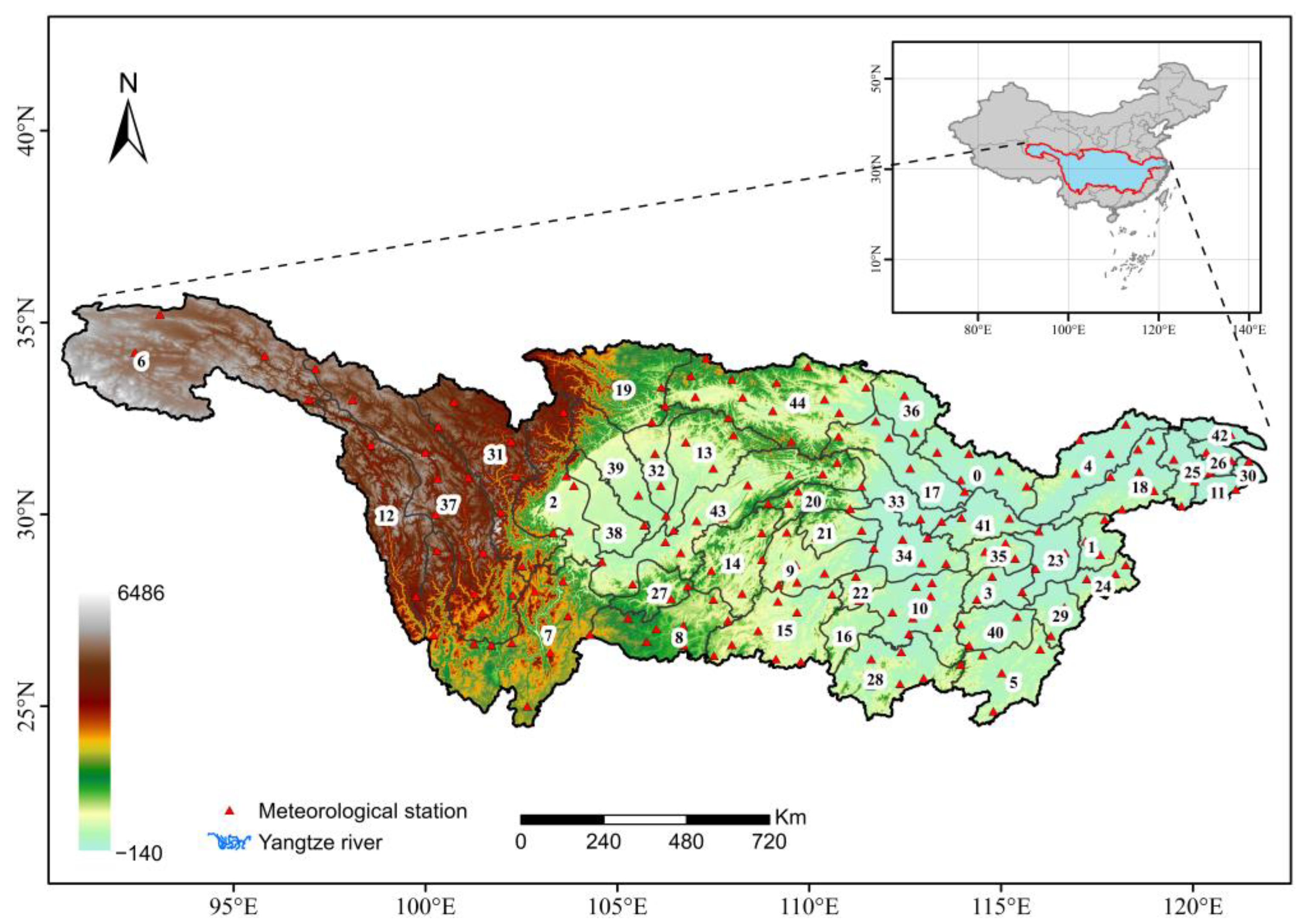
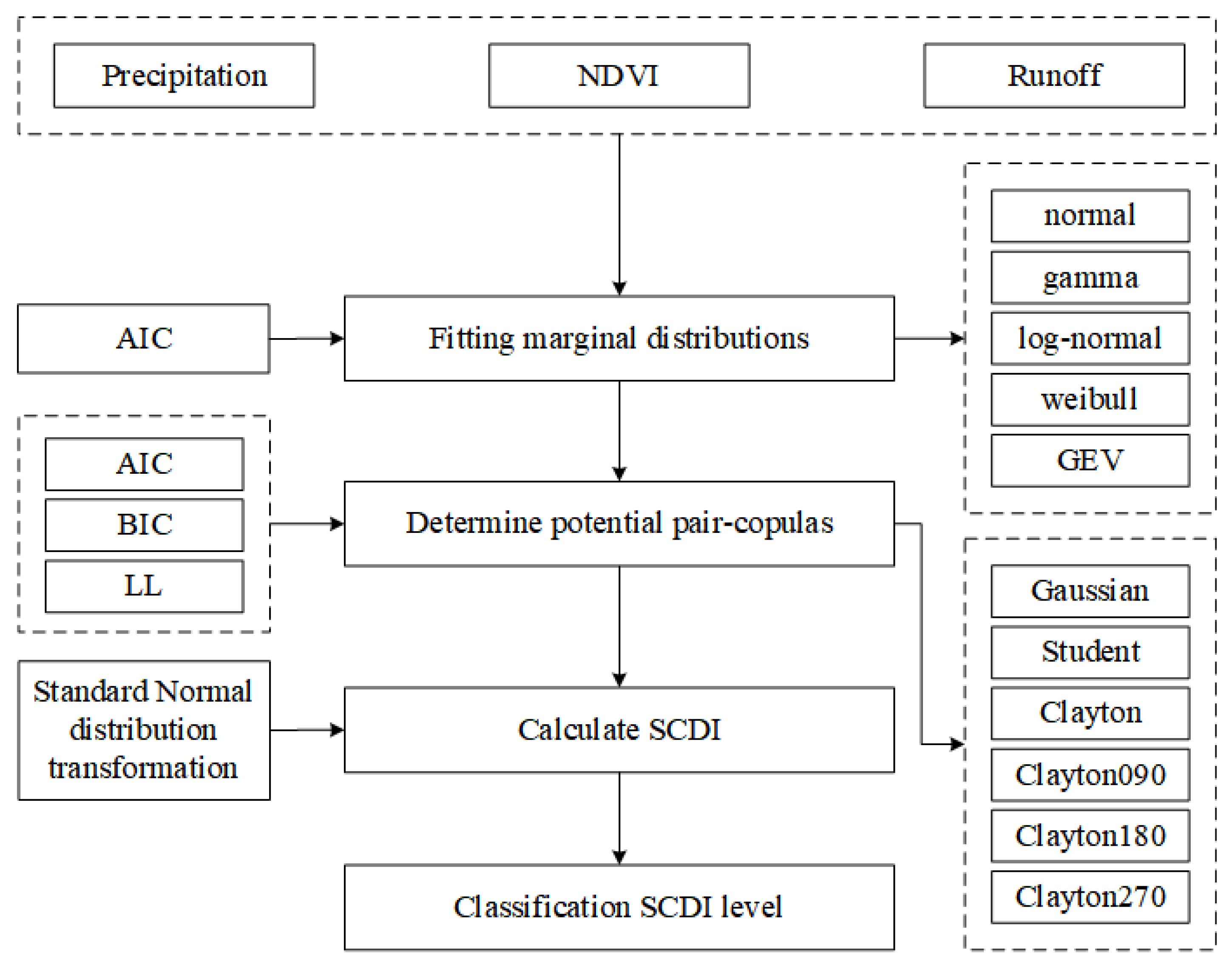
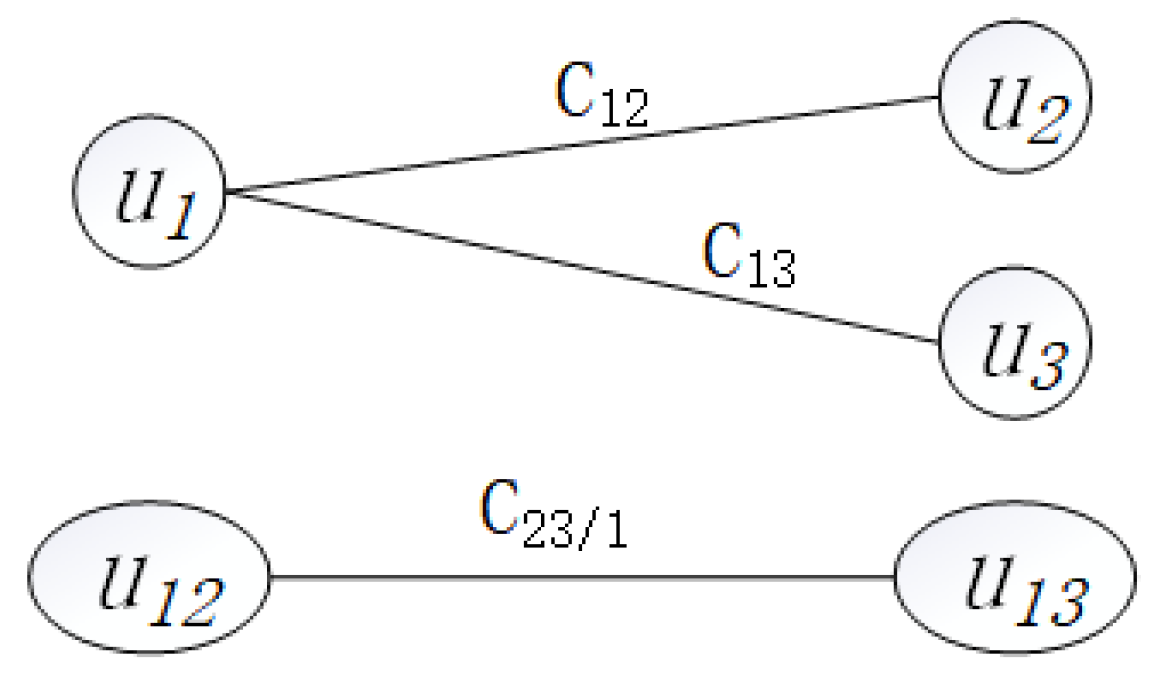
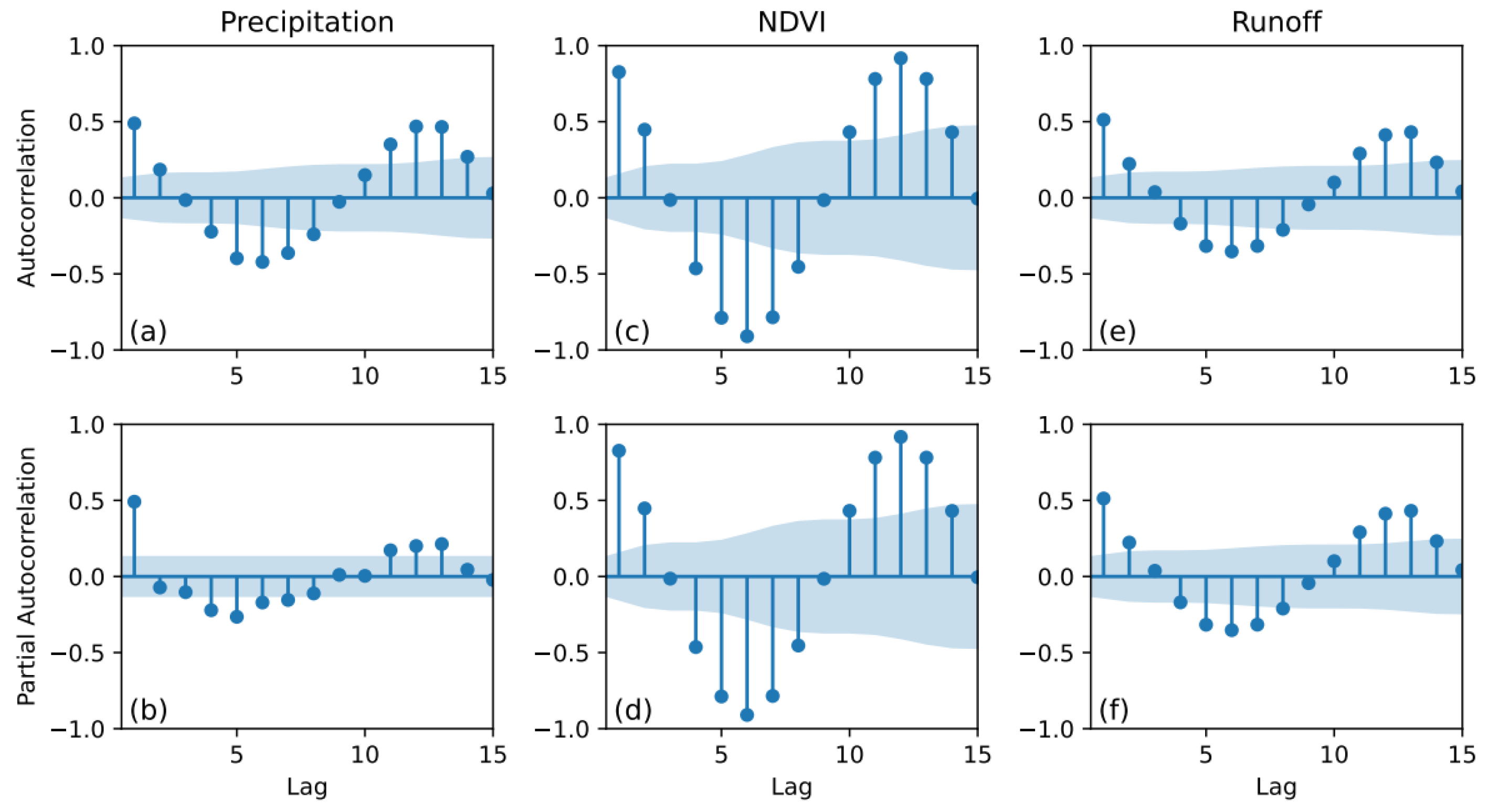
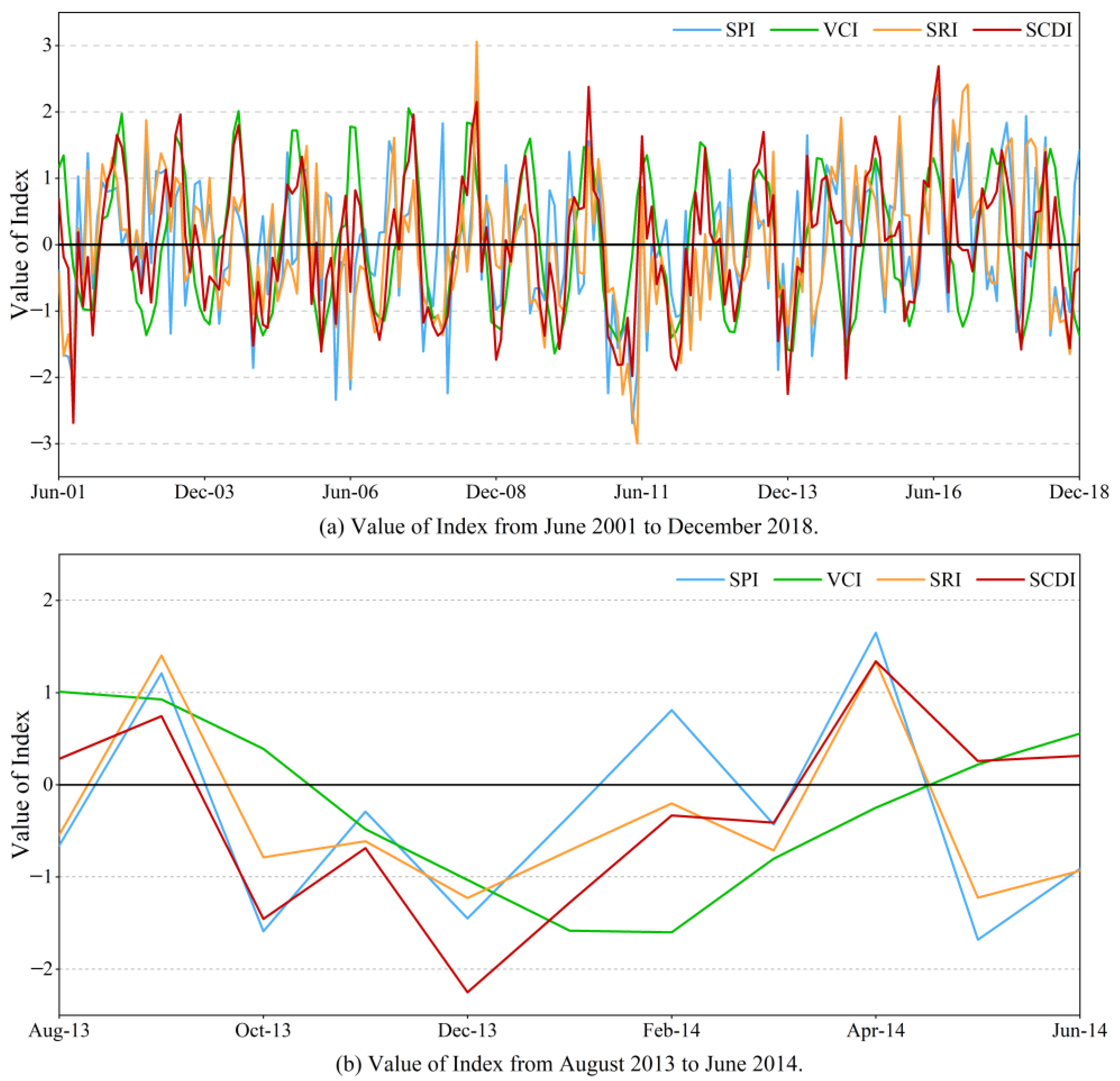

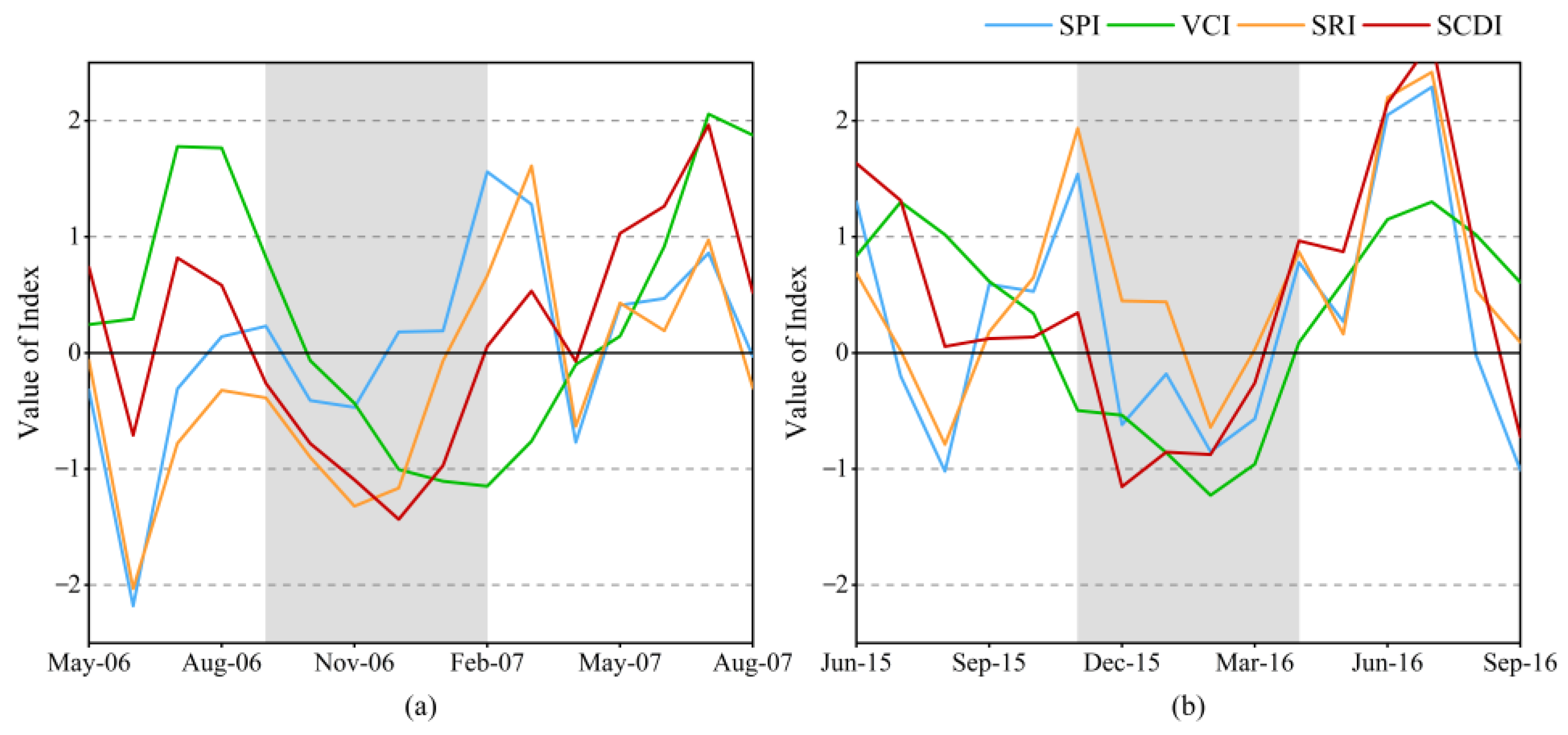
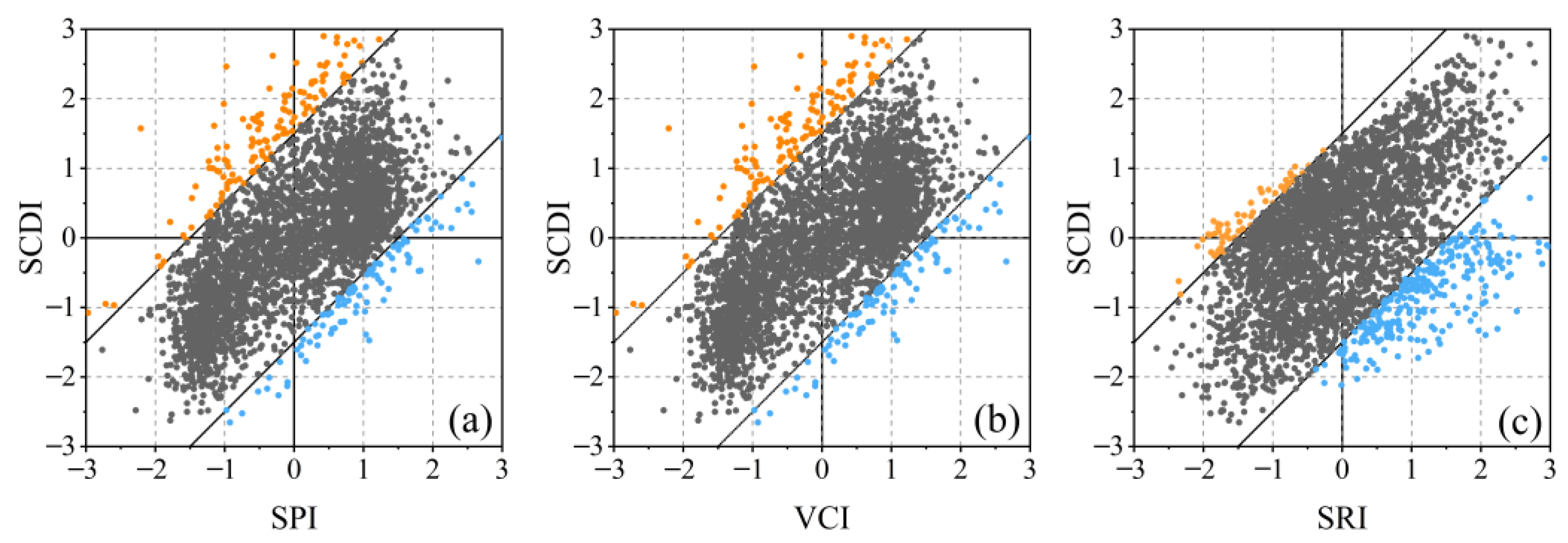

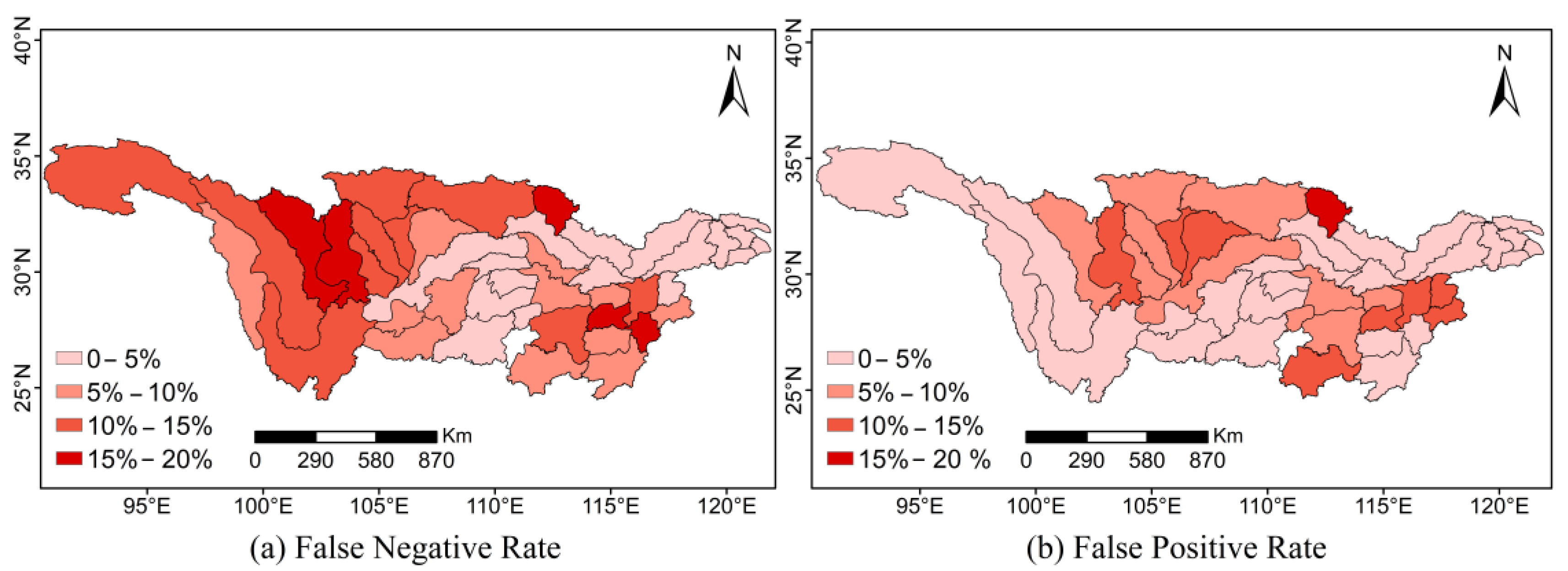

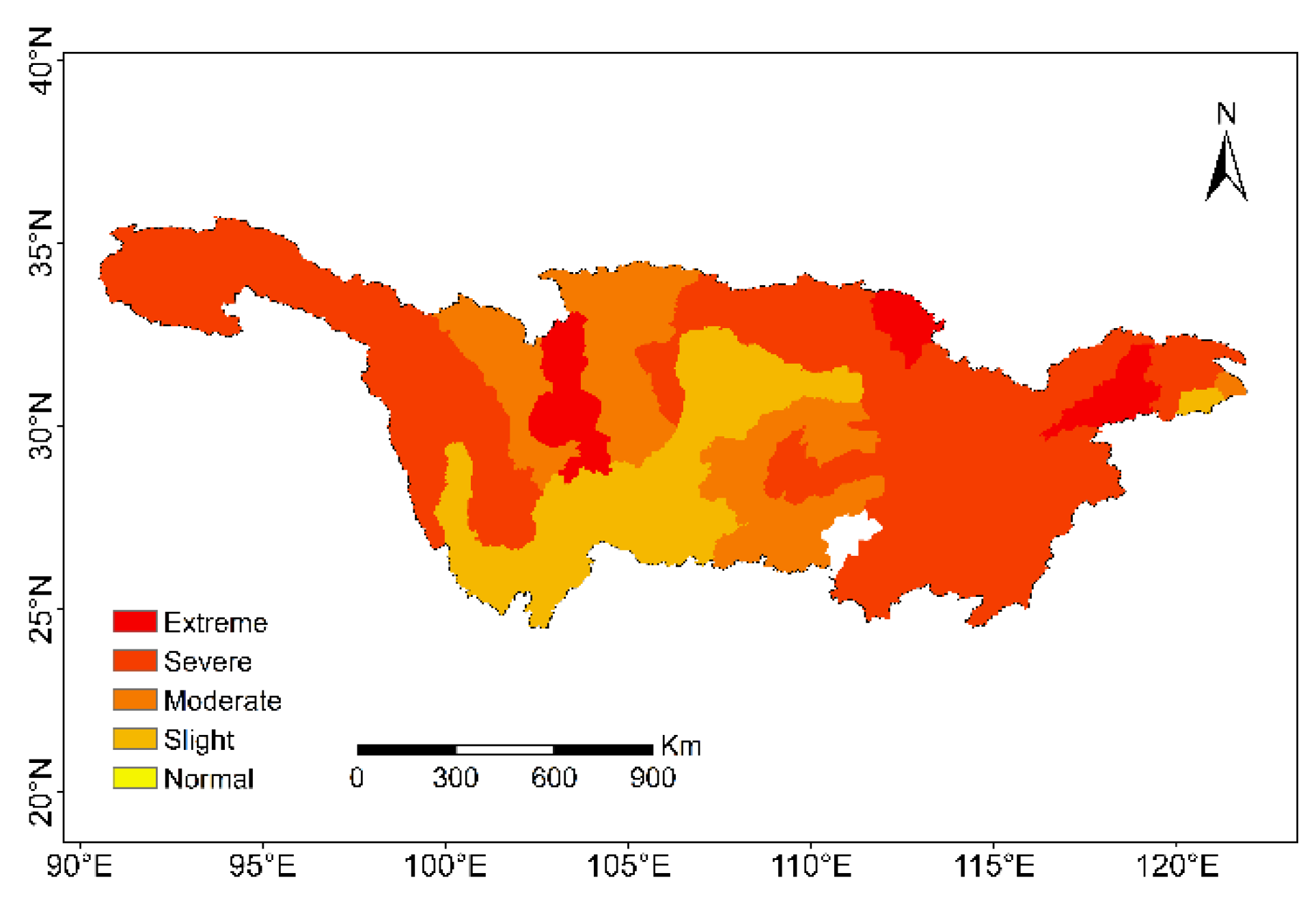

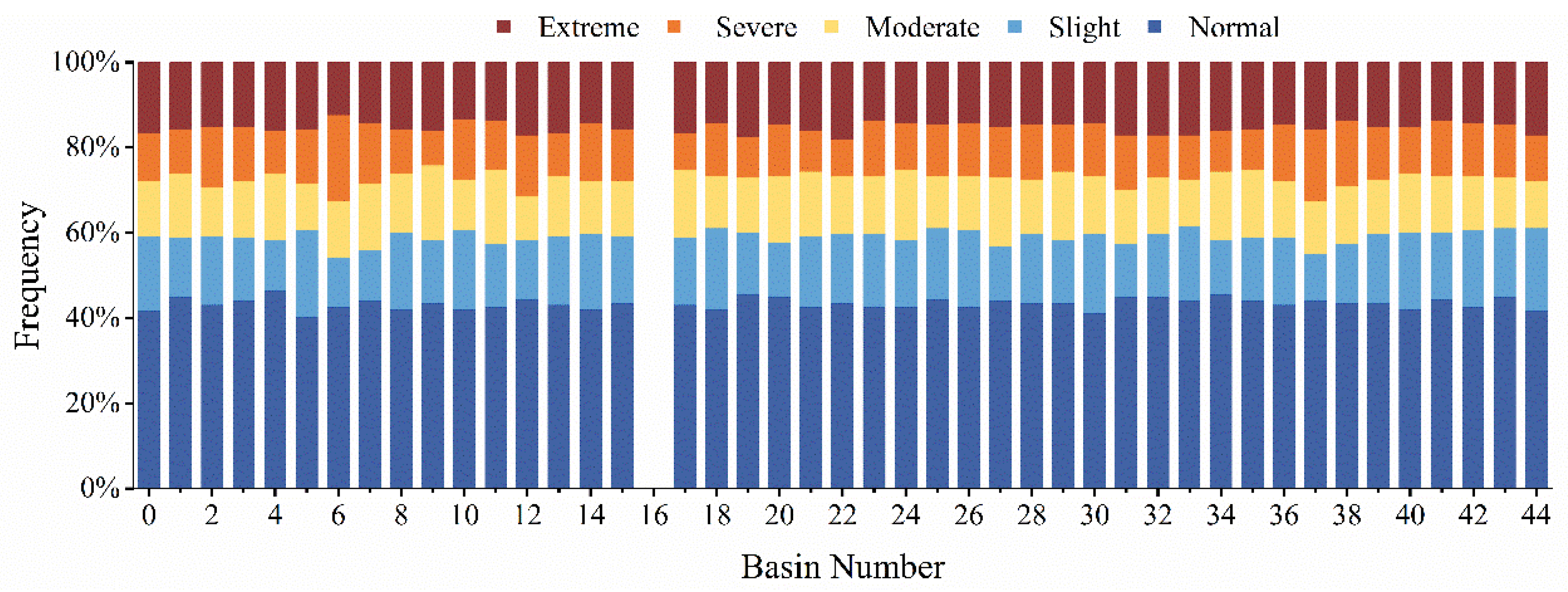
| Drought Grade | Value of SPI | Value of SRI | Value of SCDI |
|---|---|---|---|
| Neutral | SPI ≥ −0.5 | SRI ≥ −0.5 | SCDI ≥ −0.5 |
| Slight | −1.0 < SPI ≤ −0.5 | −1.0 < SRI ≤ −0.5 | −1.0 < SCDI ≤ −0.5 |
| Moderate | −1.5 < SPI ≤ −1.0 | −1.5 < SRI ≤ −1.0 | −1.5 < SCDI ≤ −1.0 |
| Severe | −2.0 < SPI ≤ −1.5 | −2.0 < SRI ≤ −1.5 | −2.0 < SCDI ≤ −1.5 |
| Extreme | SPI ≤ −2.0 | SRI ≤ −2.0 | SCDI ≤ −2.0 |
| Distribution | Normal | Gamma | Log-Normal | Weibull | GEV |
|---|---|---|---|---|---|
| Precipitation | 3433 | 3311 | 3332 | 3312 | 3328 |
| NDVI | −260 | −268 | −265 | −265 | −266 |
| Runoff | 2232 | 2109 | 2081 | 2145 | 2074 |
| Distribution | Norm. | Gaussian | Student | Clayton | Clayton090 | Clayton180 | Clayton270 |
|---|---|---|---|---|---|---|---|
| C12 | AIC | −91.66 | −16.66 | −56.86 | 2.18 | −85.67 | 2.21 |
| BIC | −88.31 | −9.96 | −53.51 | 5.53 | −82.32 | 5.56 | |
| LL | 46.83 | 10.33 | 29.43 | −0.09 | 43.83 | −0.1 | |
| C13 | AIC | −354.68 | −158.34 | −191.64 | 2.26 | −423.03 | 2.27 |
| BIC | −351.33 | −151.63 | −188.29 | 5.61 | −419.68 | 5.62 | |
| LL | 178.34 | 81.17 | 96.82 | −0.13 | 212.51 | −0.13 | |
| C23/1 | AIC | −16.31 | −0.43 | −9.39 | 2.09 | −12.52 | 2.09 |
| BIC | −12.96 | 6.28 | −6.05 | 5.45 | −9.17 | 5.45 | |
| LL | 9.15 | 2.21 | 5.69 | −0.04 | 7.26 | −0.05 |
| Norm. | SPI | VCI | SRI |
|---|---|---|---|
| Correlation | 0.60 | 0.76 | 0.61 |
| Consistency | 67.30% | 83.41% | 68.72% |
| Sensitivity | 60.15% | 51.10% | 53.10% |
| Assessment Criteria | Representation | Times | Rate |
|---|---|---|---|
| False positive rate (FPR) | SPI > 0&VCI > 0&SRI > 0 | 49 | 2% |
| SPI > 0&VCI > 0&SRI > 0&SCDI < 0 | 1 | ||
| False negative rate (FNR) | SPI < 0&VCI < 0&SRI < 0 | 48 | 0 |
| SPI < 0&VCI < 0&SRI < 0&SCDI < 0 | 0 |
Disclaimer/Publisher’s Note: The statements, opinions and data contained in all publications are solely those of the individual author(s) and contributor(s) and not of MDPI and/or the editor(s). MDPI and/or the editor(s) disclaim responsibility for any injury to people or property resulting from any ideas, methods, instructions or products referred to in the content. |
© 2023 by the authors. Licensee MDPI, Basel, Switzerland. This article is an open access article distributed under the terms and conditions of the Creative Commons Attribution (CC BY) license (https://creativecommons.org/licenses/by/4.0/).
Share and Cite
Wei, H.; Liu, X.; Hua, W.; Zhang, W.; Ji, C.; Han, S. Copula-Based Joint Drought Index Using Precipitation, NDVI, and Runoff and Its Application in the Yangtze River Basin, China. Remote Sens. 2023, 15, 4484. https://doi.org/10.3390/rs15184484
Wei H, Liu X, Hua W, Zhang W, Ji C, Han S. Copula-Based Joint Drought Index Using Precipitation, NDVI, and Runoff and Its Application in the Yangtze River Basin, China. Remote Sensing. 2023; 15(18):4484. https://doi.org/10.3390/rs15184484
Chicago/Turabian StyleWei, Hongfei, Xiuguo Liu, Weihua Hua, Wei Zhang, Chenjia Ji, and Songjie Han. 2023. "Copula-Based Joint Drought Index Using Precipitation, NDVI, and Runoff and Its Application in the Yangtze River Basin, China" Remote Sensing 15, no. 18: 4484. https://doi.org/10.3390/rs15184484
APA StyleWei, H., Liu, X., Hua, W., Zhang, W., Ji, C., & Han, S. (2023). Copula-Based Joint Drought Index Using Precipitation, NDVI, and Runoff and Its Application in the Yangtze River Basin, China. Remote Sensing, 15(18), 4484. https://doi.org/10.3390/rs15184484






